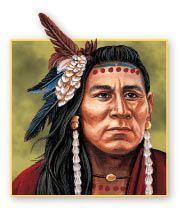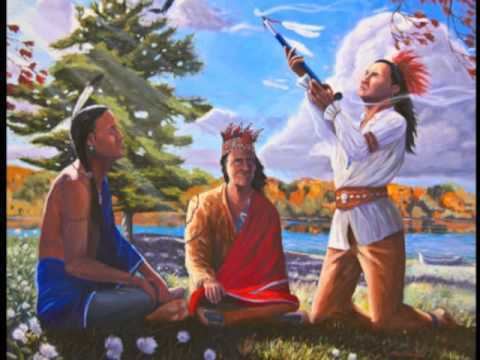 | ||
People also search for Hiawatha, Tadodaho, Peter Hare | ||
The great peacemaker
The Great Peacemaker (Skennenrahawi in Mohawk), sometimes referred to as Deganawida or Dekanawida (as a mark of respect, some Iroquois avoid using his personal name except in special circumstances) was, along with Jigonhsasee and Hiawatha, by tradition the founder of the Haudenosaunee, commonly called the Iroquois Confederacy. This was a political and cultural union of five Iroquoian-speaking Native American tribes residing in the present-day state of New York and northern Pennsylvania. The union created a powerful alliance of related Iroquoian peoples around the Great Lakes.
Contents
- The great peacemaker
- Blue meanies the great peacemaker full throttle
- Iroquois confederacy
- Prophecy of the boy seer
- Iroquois dominance
- Reverence by Native American Bahs
- In film
- References

Historians believe the confederacy may have formed in the 12th century. In the early 18th century, the Tuscarora, also an Iroquoian-speaking people, migrated north from the Carolinas and joined the Confederacy as the sixth nation.

Blue meanies the great peacemaker full throttle
Iroquois confederacy

The Great Peacemaker's name means "Two River Currents Flowing Together". Some of the numerous legends about the Great Peacemaker have conflicting information. It is reported that he was born a Huron, and by some accounts, his mother was a virgin, making the birth miraculous. Others say he was born an Onondaga and later adopted by the Mohawk. By all accounts, he was a prophet who counseled peace among the warring tribes, and he called for an end to ritual cannibalism. According to some legends, his first ally was Jigonhsasee,. She lent her home for the meeting of the leaders of the rival tribal nations, acting as a kind of United Nations. The Great Peacemaker's follower Hiawatha, an Onondaga renowned for his oratory, helped him achieve his vision of bringing the tribes together in peace.

According to the archaeologist Dean Snow, the Great Peacemaker converted Hiawatha in the territory of the Onondaga; he traveled alone to visit the Mohawk tribe who lived near what is now Cohoes, New York. Other traditional accounts hold that the Great Peacemaker consulted with Jigonhsasee about which tribal leaders to approach and she facilitated that meeting to create the confederacy.

According to some legends, initially the Mohawk rejected the message of the Great Peacemaker, so he decided to perform a feat to demonstrate his purity and spiritual power. After climbing a tree high above Kahon:ios (Cohoes Falls), the Great Peacemaker told the Mohawk braves to chop the tree down. Many onlookers watched as the Great Peacemaker disappeared into the swirling rapids of the Mohawk River. They believed he had died but the next morning found him sitting near a campfire. Greatly impressed by the Great Peacemaker's miraculous survival, the Mohawk became the founding tribe of the Iroquois Confederacy.
The tribes gathered at Onondaga Lake, where they planted a Tree of Peace and proclaimed the Great Binding Law of the Iroquois Confederacy. This confederacy influenced the United States Constitution and Anglo-American ideas of democracy. During the Albany congress of July 1754, Benjamin Franklin said of the Iroquois confederacy: “It would be a strange thing.. if six nations of ignorant savages should be capable of forming such a union, and yet it has subsisted for ages and appears indissolvable, and yet like a union should be impractical for 10 or a dozen English colonies.”
The dates Dekanawida lived, and thus the founding of the Confederacy, have not been identified with certainty. Historians and archeologists have researched an incident related in the oral history of the founding of the Confederacy. As recorded by later scholars, one account relates there was a violent conflict among the Seneca, who were the last Iroquois nation to join the confederacy as a founding member. Their violence stopped when the sun darkened and the day seemed to turn to night. Since 1902 scholars have studied the possibility that this event was a solar eclipse, as William Canfield suggested in his Legends of the Iroquois; told by “the Cornplanter" . As scholars have learned more about the representation of natural events in oral histories, scholars into the 21st century have noted eclipses that could serve to date the founding of the Confederacy, in addition to the archeological evidence. Scholars referring to an eclipse have included (chronologically): Paul A. W. Wallace, Elizabeth Tooker, Bruce E. Johansen, Dean R. Snow, Barbara A. Mann and Jerry L. Fields, William N. Fenton, David Henige, Gary Warrick, and Neta Crawford.
Since Canfield's first mention, and the majority view, scholars have widely supported a date of 1451 AD as being of a known solar eclipse and the likely founding date based on this oral account and other evidence. Some argue it is an insufficient fit for the description, and favor a date of 1142, when there was also a documented solar eclipse. A few question dating the founding of the confederacy based on the mention of the eclipse.
Archeological investigation has contributed to discussions about the founding date, as its evidence can be dated and correlated to natural events. In 1982 archeologist Dean Snow said that evidence from mainstream archeology did not support a founding of the confederacy for any dates of an eclipse before 1350 AD (thus ruling out the 1142 AD date.) By 1998 Fenton considered an eclipse earlier than the 1451 AD majority view unlikely, but possible as long as it was after 1000 AD. By 2007/8 reviews considered an 1142 AD eclipse as a possible point of reference, even if most scholars supported 1451 AD as the safe choice.
Prophecy of the boy seer
The Great Peacemaker worked all his life to bring his vision to fruition. He prophesied that a "white serpent" would come to his people's lands and make friends with them, only to deceive them later. A "red serpent" would later make war against the "white serpent", but an Indian boy would be given a great power. He would be accepted as a chosen leader by the people of "the land of the hilly country." The boy stays neutral in the fight, and he speaks to the people, who number as the blades of grass, but he is heard by all. After a season, a "black serpent" would come and defeat both the "white" and "red serpents". According to the prophecy, when the people gathered under the elm tree become humble, all three "serpents" would be blinded by a light many times brighter than the sun. Deganawidah said that he would be that light. His nation would accept the "white serpent" into their safekeeping like a long-lost brother.
Iroquois dominance
The Great Peacemaker established a council of clan and village chiefs to govern the confederacy. In each tribe, which had matrilineal kinship systems of descent and property-holding, power was shared between the sexes. Men held the positions of hereditary chiefs through their mother's line; clan mothers ruled on the fitness of chiefs and could depose one they opposed. Most decisions in council were made by consensus, to which each representative had an equal voice. Early anthropologist Lewis H. Morgan attributed the regional dominance achieved by the Iroquois to their superior organization and coordination compared to other tribes; George Hunt also thought there was a factor of economic determinism, with their need for furs for the European trade and their superior geographic position controlling most of central and western New York. The oral laws and customs of the Great Law of Peace became the constitution of the Iroquois Confederacy, established by the 16th century or earlier.
Reverence by Native American Bahá'ís
Some members of the Bahá'í Faith have connected the signs of a Prophet, as described by Bahá'u'lláh (Prophet-founder of the Baha'i Faith), with the Peacemaker. As such, many Native American Bahá'ís in North America (and some non-Native) revere the Peacemaker as a Manifestation of God. See Bahá'í Faith and Native Americans.
